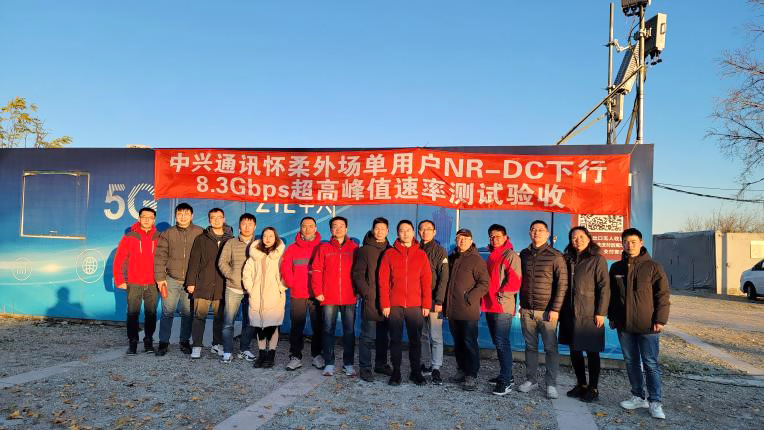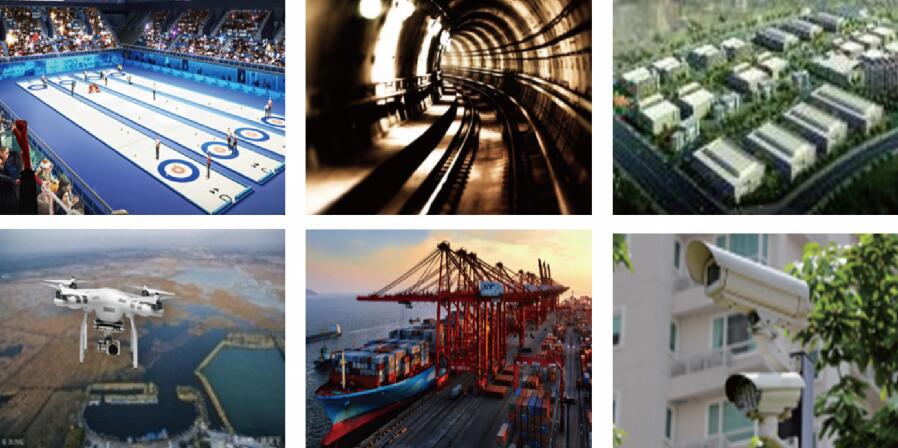5G is enabling a new era of internet of everything (IoE). As the 5G mid- and low-band spectrum resources are relatively limited, mmWave has come into the spotlight with its benefits of larger bandwidth, higher capacity, and less interference. Especially for the ultra-high bandwidth and ultra-low latency vertical applications, mmWave can provide better guarantee and better user experience. Therefore, 5G mmWave has attracted wide attention in the industry and will be an important direction in the next wave of 5G.
Comprehensive mmWave Technology Development
The continuous 5G mmWave trials have greatly promoted the development of mmWave technology. Meanwhile, higher requirements are put forward for the actual wireless performance of services, which can be addressed from multiple dimensions such as wireless coverage extension, network capacity improvement, and network architecture evolution.
Expanding mmWave Coverage Capability
At high frequencies, 5G mmWave suffers from high propagation loss and poor diffraction and penetration. mmWave signals can be easily blocked by buildings, trees, rain, snow, humans, or vehicles. resulting in high indoor-to-outdoor propagation losses and limited coverage. This is the biggest challenge facing the 5G mmWave communication system. ZTE has introduced multiple coverage enhancement solutions to expand mmWave network coverage.
—Hybrid analog-digital beamforming scheme: In the analog domain, single-panel based beamforming of high frequency signals is implemented through a low-cost phase shifter. In the digital domain, multi-panel based beamforming is implemented through the baseband processor. By increasing the number of an tenna elements in a large array, we can get a higher equivalent isotropically radiated power (EIRP) to overcome the impact of fast attenuation in mmWave.
—Intelligent beam management: More refined beams and scene-based beam configuration solution are designed to allow more flexibility in mmWave beams and solve the coverage hole problem while increasing the signal transmission gain of the base station and UE, reducing the interference and improving the data transmission rate of the system.
—Multi-TRP enhancement: Multiple transmission/reception points (multi-TRPs) are used to perform coordinated transmission and reception of multiple beams from various angles, thus reducing the adverse effect of blockage and improving the robustness of the radio link. In this way, mmWave application in the uRLLC scenario becomes possible.
—Reconfigurable intelligent surface: An intelligent and controllable wireless propagation environment can be constructed through ZTE RIS, which uses the reconfigurable intelligent MetaSurface. In this way, the non-line-of-sight transmission problem of mmWave can be solved, further expanding the coverage range and enabling the gradual evolution to 6G.
Improving mmWave Network Capacity
Abundant frequency resources, large bandwidth, large capacity, and ultra fast speeds are the greatest advantages of 5G mmWave system.
mmWave downlink capacity improvements can be achieved through DDDSU frame structure, MU-MIMO and scheduling enhancement, making FWA and AR/VR viable. In 2018, ZTE completed the real-time UHD 4K video transmission in Tokyo, Japan to verify the real-time performance of mmWave networks in complex and dense urban areas, in 2020 the industry's most complete mmWave terminal interconnection test, and in November 2021 the industry's first NR dual connectivity (DC) field test with a single-user downlink peak rate of above 8.3 Gbps (Fig. 1).

Fig. 1. ZTE achieved a single-user downlink peak rate of above 8.3 Gbps in an NR-DC field test in November 2021.
mmWave uplink capacity improvements can be achieved through DSUUU frame structure and high transmission power terminal, making mmWave applicable to uplink-data-intensive vertical applications like 4K/8K video live broadcasts and machine vision. ZTE, together with other partners, achieved the world’s first DSUUU frame structure-based 5G mmWave 8K video upstreaming demonstration through lab testing in May 2021. In September, ZTE assisted China Unicom in completing the world’s first field demonstration of DDDSU frame structure-based end-to-end 8K video service. In October, it completed the industry's first NR-DC field test with a single-user uplink peak rate of 2.2 Gbps.
The dynamic frame structure solution is used to cater to scenarios where there are dynamic differentiated requirements for UL/DL services due to service type change or time period change. Different DL/UL frame structures can be selected and time granularities can be adjusted according to the latency, traffic and PRB utilization requirements of the application scenarios, and the uplink/downlink ratio can be automatically adjusted according to the change of uplink/downlink traffic. Thus, the mmWave radio resources can be dynamically allocated to match the service requirements, improving the network capacity and spectrum efficiency of mmWave.
Network Architectures Adaptive to Application Scenarios
The 5G mmWave network architecture supports the NSA (EN-DC) network architecture utilizing LTE, and also the three options of SA architecture(NR-DC, NR-CA and FR2 only).
The mmWave SA or NSA architecture depends on the operator's objectives (regional and service requirements), investment plans, and maturity of the industry chain. For ToC and FWA application scenarios, mmWave is mainly used for supplementary coverage and hotspot coverage. The area covered by the mmWave base station must be covered by LTE or low-frequency NR. Therefore, NSA networking is preferred in the early stage of 5G mmWave deployments. In the vertical industry application scenario, mmWave is mainly used for private network deployments, and the SA networking becomes the inevitable choice. A new SA network using FR2 can be built with its control and management independent from the operator network. Operators can also deploy NR-DC or NR-CA by overlaying the early 5G low-frequency network with mmWave. Only the mmWave base station needs to be deployed without deploying the core network (5GC) for NR-DC or NR-CA, thus saving the operator's CAPEX and OPEX and increasing the network capacity.
ZTE has been actively researching the SA network architectures of NR-DC, NR-CA and FR2 only, while accelerating the verification of the NR-DC technology. ZTE completed the world's first NR-DC (FR1+FR2 DC) laboratory test in August 2021, and the industry's first NR-DC field performance test with industry-leading uplink and downlink performance in October.
Exploring More Application Scenarios
Due to its large bandwidth, 5G mmWave can provide a higher 5G transmission rate, but with limited range. Therefore, it is more applicable to capacity boost in hotspots, FWA use or ToC hotsot coverage. In addition, the large capacity and low latency of mmWave also offer great potential for vertical applications (Fig. 2).

Fig. 2. Vertical industry sycenarios for mmWave.
FWA can be complemented by 5G mmWave. Compared with wired FTTH, 5G mmWave has obvious advantages in peak rates and large capacity. Therefore, FWA can provide a lower-cost way to deliver faster broadband speeds over mmWave to homes and business, bringing operators opportunities to expand market share and increase revenues.
Indoor and outdoor ToC hotspot coverage is the major application requirement for 5G mmWave. For airports, railway stations, large shopping malls, and other high-traffic indoor areas, mmWave hotspots can be conveniently deployed. For outdoor hotspot areas such as squares, gymnasiums, and busy streets where there are a large number of users and high traffic demands during peak hours, the large bandwidth available in mmWave can be utilized for high-speed data transmission services, and also for spatial division multiple access operation to simultaneously serve multiple user.
Large-bandwidth and low-latency vertical applications require the use of 5G mmWave. 5G mmWave can carry big video services such as high-speed access, live video broadcast, machine vision, and VR, and is applicable to a variety of vertical industry scenarios such as stadiums, smart factories, smart subways, and smart ports. In scenarios like stadiums, mmWave has an irreplaceable advantage in big video transmission. Streaming UHD single-channel video requires up to 200 Mbps of bandwidth. FR1 cannot meet the large-capacity scenarios that require multi-channel video streaming. Only by introducing mmWave can the bandwidth and capacity requirement be met. In the smart subway, 5G mmWave serves as the wireless backhaul of the train-to-ground communication system to perfectly carry large-capacity services such as real-time video monitoring and in-train ToC service. In the smart factory, 5G mmWave is suitable for carrying material inspection, quality inspection, 3D mapping, and other machine vision services. In the smart port, 5G mmWave can be used to meet large-capacity requirements of HD video backhaul for quay-side gantry crane, and the sub-6 GHz bands high reliability requirements of services such as PLC remote control.
Conclusion
With the rapid development of 5G and the user's increasing demands, 5G mmWave is being embraced by vertical industries, operators, equipment manufacturers and terminal manufacturers when the present spectrum resources are limited. It is believed that 5G mmWave will be widely used in scenarios like vertical industries and ToC hotspots with the upcoming large-scale deployment of industry applications.